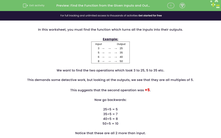In this activity, we will be finding the function that turns all the inputs into their outputs.
Example:
|
||||||||||||||||||||||||||||||||||
In the example above, we have to work out what should go in the middle that turned the input into the output.
If we look at the two columns, we can see that there is a pattern. Each of the numbers in the input column has been divided by 3 to get the answer in the output column. So, each of those empty boxes needs to have ÷ 3 written in.
If x is the missing function, then we can write this as x ÷ 3 or x/3
Sometimes, we will have two steps to follow to find the function.
|
|||||||||||||||||||||||||||||||||||||||||||
We want to find the two operations that took 3 to 25, 5 to 35 etc.
This demands some detective work, but looking at the outputs, we see that they are all multiples of 5.
This suggests that the second operation was x 5.
Now go backwards:
25 ÷ 5 = 5
35 ÷ 5 = 7
40 ÷ 5 = 8
50 ÷ 5 = 10
Notice that these are all two more than the input. So, the first empty boxes should be + 2
If we call the function x, then we get (x + 2) x 5
This might look a bit tricky, but the key is to look carefully at the numbers in the output column and see if there is anything that they have in common.
Are you ready to have a go?









